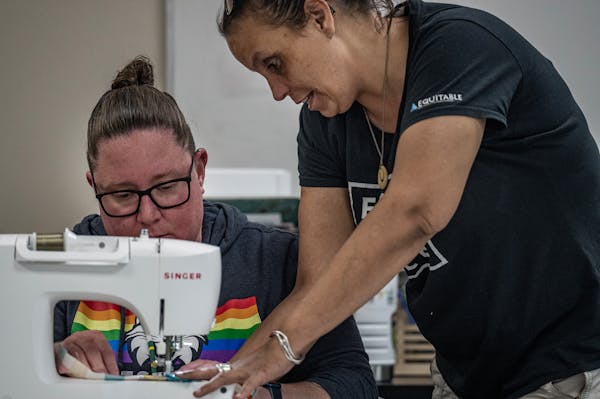CASS LAKE, Minn. – The regalia worn by Day-Bway-Wii-Da-Moog was passed down from his father, vibrant blue and yellow even after 40 years, affixed with plumes of feathers and intricately beaded butterflies.
The 58-year-old Leech Lake Band of Ojibwe citizen attends only the Cass Lake powwow each year on the Leech Lake Reservation, about 865,000 acres that sprawl into four counties in north-central Minnesota.
He goes to nurture a connection to his late father.
"We argued quite a bit, but this was one thing we could agree on," he said.
Day-Bway-Wii-Da-Moog was one of hundreds dancing to powerful drumbeats and song at the Leech Lake powwow over the weekend — a three-day event that began Friday night with the grand entrance of more than 200 dancers at the Veterans Memorial powwow grounds.
From toddlers to elders, dancers wore dresses with clinking, cone-shaped jingles, colorful ribbons, fringed pants and feathered bustles as they entered a circular arena surrounded by bleachers, drum groups and the rich scents of tobacco and fry bread.
Powwows are held by tribes across the country, a celebration of culture, family, friendship and food that blend modern life with old traditions. Many travel hundreds of miles to partake in another tribe's event. The Leech Lake band plans several powwows a year in the warmer months, with attendance often reaching 1,000 on a single day.
"We're celebrating life; each other's company," said David Northbird Sr., one of the two masters of ceremony Friday night. "We weren't always allowed to do it."
The history
Powwows, ni-mi-win in Ojibwe, are a relatively new, intertribal tradition that include a series of dance styles and sometimes contests with prizes. As part of efforts to assimilate Indigenous people, the U.S. government banned Native American religious and spiritual traditions, including certain dances, in the late 1800s.
More of a social event than a religious ceremony, powwows became a way to express culture in the mid-20th century, as a way to skirt the law that remained unchanged by Congress until 1978 under the American Indian Religious Freedom Act.
How to attend
It's a common misconception that powwows are closed events, said Rodney Johnson, who coordinates them for the Leech Lake band.
"But everyone is welcome" to the hours-long events complete with traditional and fair-style foods, craft vendors and campgrounds, he said.
All that's asked is that attendees are respectful and follow a few rules: powwows are sober, with no drugs and alcohol allowed on site. Viewers shouldn't enter the dancing arena unless asked to be there, such as when veterans are honored. The master of ceremonies will typically say when it's OK to take photos and when it is not, or whether it is time to stand or remove headwear.
The outfits dancers wear are called regalia and not costumes, and shouldn't be touched without asking first.
If a loose feather is found, leave it and let someone in the master of ceremonies stand know so it can be handled properly, because feathers are sacred items.
Feel free to ask questions, but prepare for a joke, like the one Day-Bway-Wii-Da-Moog offered about the old shell casings he wore around his neck:
"Each one of these was a German soldier," he said.
Powwows are a good way for non-Native people to see contemporary Native Americans expressing culture, said Jill Doerfler, a University of Minnesota Duluth American Indian studies professor and a White Earth Nation descendant.
It can help "undermine the stereotypes and things we see replicated in dominant society," she said, of representations of Native Americans still being set in the historic past.
The regalia
Wendy Merrill's red jingle dress was made by Adrienne Benjamin, a master jingle dress maker from the Mille Lacs Band of Ojibwe.
The dress, and the dance of the same name are important to the Mille Lacs band, where it is said the dress originated when a man with a sick daughter during the 1918 pandemic dreamed about one. He made the dress, and when she danced in it, she was healed, Merrill said, and today the dress is known as the healing dress.
"You're dancing to heal and you're dancing for the people who can't," said Merrill, who attended with her daughter. "And it makes me feel beautiful."
Powwow regalia can be a personal reflection of the wearer. On Friday, a child wore a "Frozen" themed glittering shawl and a teen paired a Tupac T-shirt with a ribbon skirt. The clothes are usually labor intensive to make and many items are handed down through generations.
"Regalia has a deep, personal meaning regardless of what anyone might see," Doerfler said. "All regalia has a story."
Red has become a more common color in recent years, she said, related to the movement to recognize and find murdered and missing Indigenous women and relatives.
The mood
Powwows can be lighthearted, with gentle ribbing and jokes by the masters of ceremony.
For Candace Gotchie, of Ball Club, Minn., whose granddaughters no longer dance because they're too busy "chasing boys around," powwows are spiritual.
"It just feels good to be here," she said.
They are solemn as respect is paid to flags, veterans and elders, and they are breathtaking as dancers become lost in the drumming and melodic song.
"You just close your eyes and dance," Northbird said.
If you go:
Leech Lake holds its final powwow of the season Sept. 15-17 at its Battle Point grounds on Battle Point Drive in Federal Dam, Minn. Grand entries are held at 1 p.m. and 7 p.m. Saturday and 1 p.m. Sunday.
New director of Minneapolis Animal Care and Control is longtime abuse investigator Tony Schendel
Brooklyn Park police make arrest after asking for help in search for man suspected of sexual assault at gunpoint

Attorney Tayler Rahm wins GOP backing in battleground Second District
North Oaks withdraws request for density exemption from Met Council

